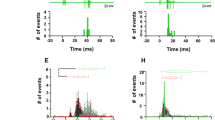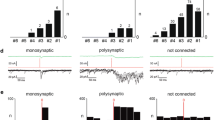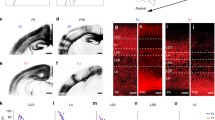Abstract
Corticospinal (CS) axon terminations in several species are widespread early in development but are subsequently refined into a spatially more restricted distribution. We studied the role of neural activity in sensorimotor cortex in shaping postnatal development of CS terminations in cats. We continuously infused muscimol unilaterally into sensorimotor cortex to silence neurons during the postnatal CS refinement period (weeks 3–7). Using anterograde transport of WGA-HRP, we examined the laterality of terminations from the muscimol-infused (i.e., silenced) and active sides in the spinal cord, as well as in the cuneate nucleus and red nucleus. We found that CS terminations from the muscimol-infused cortex were very sparse and limited to the contralateral side, while those from the active cortex maintained an immature bilateral topography. Controls (saline infusion, noninfusion) had dense, predominantly contralateral, CS terminations. There was a substantial decrease in the spinal gray matter area occupied by terminations from the side receiving the blockade and a concomitant increase in the area occupied by ipsilateral terminations from the active cortex. Optical density measurements of HRP reaction product from the active cortex in muscimol-infused animals showed substantial increases over controls in the ratio of ipsilateral to contralateral CS terminations for all laminae examined (IV–V, VI, VII). Our findings suggest that ipsilateral dorsal horn terminations reflect new axon growth during the refinement period because they are not present there earlier in development. Those in the ventral horn are present earlier in development and thus could reflect maintenance of transient terminations. Increased ipsilateral terminations from active cortex were due to recrossing of CS axons in lamina X and not to an increase in labeled CS axons in the ipsilateral white matter. Examination of brain stem terminations suggested that, between postnatal weeks 3 and 7, development of corticocuneate terminations also is activity-dependent but that development of corticorubral terminations is not. Activity-dependent CS development is a plausible mechanism by which early motor experiences could shape the anatomical and functional organization of the motor systems during a critical postnatal period.
Similar content being viewed by others
Author information
Authors and Affiliations
Additional information
Received: 4 August 1998 / Accepted: 2 September 1998
Rights and permissions
About this article
Cite this article
Martin, J., Kably, B. & Hacking, A. Activity-dependent development of cortical axon terminations in the spinal cord and brain stem. Exp Brain Res 125, 184–199 (1999). https://doi.org/10.1007/s002210050673
Issue Date:
DOI: https://doi.org/10.1007/s002210050673




